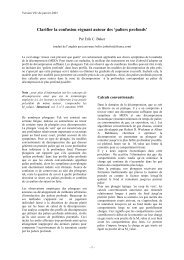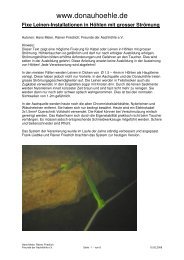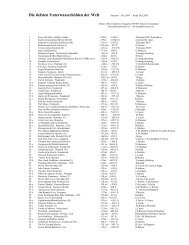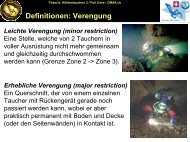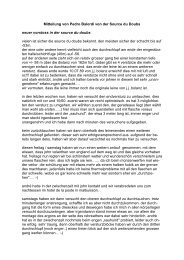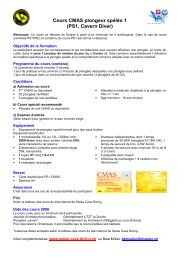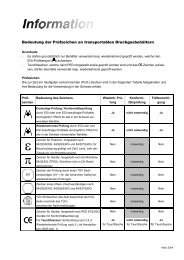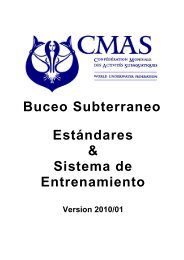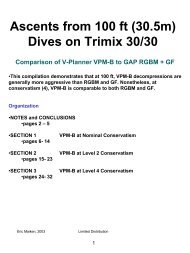cave diving and the nss - bei Swiss-Cave-Diving
cave diving and the nss - bei Swiss-Cave-Diving
cave diving and the nss - bei Swiss-Cave-Diving
You also want an ePaper? Increase the reach of your titles
YUMPU automatically turns print PDFs into web optimized ePapers that Google loves.
42 CAVE DIVING COMMUNICATIONS<br />
REELS AND LINE MARKERS 43<br />
Back-to-back arrows indicating midpoint on line<br />
Arrows placed back to back mark <strong>the</strong> spot as <strong>the</strong> midway distance<br />
between two entrances. Although <strong>the</strong> travel distance between <strong>the</strong><br />
entrances may be equal, o<strong>the</strong>r factors, such as current strength or<br />
potential restrictions, may not be reflected by <strong>the</strong> line arrows. It<br />
may be easier, if not wiser, to plan to return along a known<br />
passageway ra<strong>the</strong>r than continue on should an emergency develop.<br />
The RIGHT way versus <strong>the</strong> WRONG way of<br />
identifying <strong>the</strong> exit route at a "T" in lines<br />
Arrows are always used to mark <strong>the</strong> intersection of lines <strong>and</strong><br />
should be placed on <strong>the</strong> OUTBOUND side of <strong>the</strong> intersection to<br />
avoid confusion. Arrows should be within a few inches of <strong>the</strong><br />
intersection, always within easy reach of it.<br />
than one dive team is using <strong>the</strong> same primary reel from <strong>the</strong><br />
entrance of <strong>the</strong> <strong>cave</strong> to <strong>the</strong> start of <strong>the</strong> permanent line (we will<br />
return to this specific practice later). As with any o<strong>the</strong>r device<br />
installed on a guideline, clo<strong>the</strong>spins should be identified as belonging<br />
to <strong>the</strong> installer. Since <strong>the</strong>se clo<strong>the</strong>spins are intended to be<br />
temporary, <strong>the</strong>y should be removed from <strong>the</strong> <strong>cave</strong> system upon<br />
conclusion of <strong>the</strong> dive or project. Needlessly ab<strong>and</strong>oned clo<strong>the</strong>spins<br />
are a source of visual litter within <strong>the</strong> <strong>cave</strong> system.<br />
Every <strong>cave</strong> diver needs to incorporate plastic line arrows <strong>and</strong><br />
clo<strong>the</strong>spins into his equipment. Stowing of <strong>the</strong>se devices can be<br />
as easy as threading some spare guideline through a piece of<br />
surgical tubing <strong>and</strong> <strong>the</strong>n tying <strong>the</strong> tubing into a pouch or pocket.<br />
When required, markers can be removed without dumping <strong>the</strong> contents<br />
of <strong>the</strong> pouch onto <strong>the</strong> floor of <strong>the</strong> <strong>cave</strong>. The exact number<br />
of line markers required is dependent on <strong>the</strong> intricacy of <strong>the</strong> particular<br />
dive plan. Current NSS <strong>cave</strong>-<strong>diving</strong> course requirements<br />
cite three line markers, ei<strong>the</strong>r plastic line arrows or clo<strong>the</strong>spins, as<br />
a minimum. At least one spare plastic line arrow should be carried<br />
by each diver to be used to replace missing or broken arrows. It<br />
is <strong>the</strong> responsibility of all members of <strong>the</strong> <strong>cave</strong>-<strong>diving</strong> community<br />
to keep guidelines in sound order. Just as we have <strong>the</strong> responsibility<br />
to repair damaged guideline, we also have <strong>the</strong> responsibility<br />
to replace missing line markers.<br />
A final word on line markers. The above examples represent<br />
generally accepted methods of marking guidelines. The general<br />
policies discussed are recommended by <strong>the</strong> NSS-CDS. In everyday<br />
real life some exceptions are necessary <strong>and</strong> also generally<br />
accepted. At certain sites, such as those frequented by open-water<br />
divers, line markers are not utilized until well within <strong>the</strong> <strong>cave</strong> system.<br />
This is done to avoid potential confusion among <strong>the</strong> untrained<br />
<strong>and</strong> to avoid encouraging <strong>the</strong>m to travel far<strong>the</strong>r into a system. We<br />
do not wish to be guilty of enticing <strong>the</strong>se untrained individuals into<br />
reliance on any system of which <strong>the</strong>y have no knowledge. They<br />
may well accept practices at one location as gospel for ano<strong>the</strong>r,<br />
more complex site. Also, as one ventures deeper into any <strong>cave</strong><br />
system, one is apt to find fewer <strong>and</strong> fewer directional indicators.<br />
The initial dives into most <strong>cave</strong> systems are done to set up <strong>and</strong><br />
ga<strong>the</strong>r surveying information. Directional reminders are installed<br />
only for <strong>the</strong> safety of <strong>the</strong> survey team. Additional identification is<br />
left to future teams.




